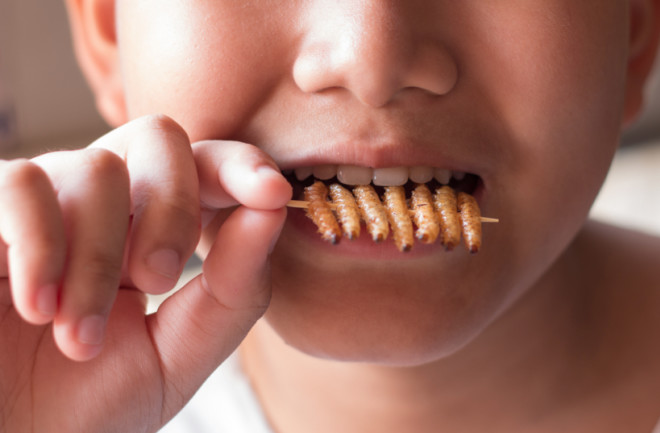Anticipating food shortages in coming decades, some companies are touting insects as tomorrow’s protein source. Entrepreneurs are jumping on board and chips made of crickets are hitting grocery shelves. But scientists advise caution, saying more research is needed on the environmental impact of rearing insects at an industrial scale.
As sustainability experts assess whether insects should be the food of the future, anthropologists are trying to answer the same question about the past: Were insects a part of our ancestors’ diet?
The question is challenging because, unlike butchered animal bones, arthropod meals leave next to nil for archaeologists to recover. But scholars recently have compiled other lines of evidence — from the ant-eating habits of chimpanzees to elemental signatures in hominin bones — and built a compelling case. Insects such as termites likely provided ancient hominins with protein long before our ancestors became proficient hunters.
The Forgotten Food
“If you asked a paleoanthropologist, ‘Did early hominins eat insects?’ … 99 percent of them would say, ‘Yeah, sure,’” says Julie Lesnik, an anthropologist who wrote a book on the subject. “It’s just always … been kind of glanced over.”
In part, this is due to the preservation issues. Most insects are eaten whole. In some cases, their exoskeletons may survive and be found at archaeological sites. But, then, it’s hard say whether the critter died naturally or for a hominin’s dinner. Most scholars investigating our ancestors’ diets have focused on conspicuous, well-preserved remains: butchered bones revealing meat consumption.
Additionally, there’s some bias on the part of the researchers. “Since most of the people doing the excavating and the analysis don’t eat insects in their diets, they’re not thinking of it as a food to look for,” explains Lesnik, an assistant professor at Wayne State University.
Insect Eating Runs in the Family
But looking beyond the meals of Western scientists, entomophagy (insect eating) is easy to find. Societies around the world today consume over 2,000 insect species.
The habit is also widespread among our evolutionary cousins. As primatologist William McGrew documented, some amount of insect food is eaten by primates “across the board,” from the smallest mouse lemur to the largest gorilla. In particular, primates target five arthropod groups: beetles, termites, Hymenoptera (ants, bees and wasps), Lepidoptera (butterflies and moths) and Orthoptera (locusts and crickets).
These critters are easy prey, as they’re found in droves during some stage of their life cycles, such as when moths are caterpillars. They’re also rich in protein, fat and micronutrients. Insects can provide 330 to 588 calories, one study found, compared to 50 to 370 calories from fruit or leaves of the same weight.
Of course, insects are small packages, so primates have to swallow a lot to match one fruit’s worth of energy. Our closest evolutionary relatives, chimpanzees, solve this problem by using sticks, leaves and grasses to “fish” ants from colonies — generally catching hundreds to thousands of ants per fishing session. At the upper extreme, one study estimated chimps in Nigeria can nab upwards of 22,000 army ants in one meal.
(In that study, researchers counted ant heads in chimp poop samples. To understand what proportion of insect heads make it through digestion into feces, one of the authors did a self-experiment several times: That researcher ate 100 ants “immobilized in whiskey” and counted the heads in “subsequent excreta.” For science!)
If our closest evolutionary relatives and many peoples today dine on arthropods, it reasons that human ancestors did as well. But is there any evidence directly tied to those hominins?
You Are What You Eat
There may be for at least one hominin type, Australopithecus robustus. These creatures, who lived between 1 and 2 million years ago, were Australopiths like Lucy, but from a species with especially large chewing muscles and molar teeth.
At South African A. robustus sites, over 100 similar-looking bone tools have been found. The implements are animal bone shafts with rounded, polished ends. Microscopic imaging revealed fine parallel scratches emanating from the tips — marks made when the tools were used. In several studies (here, here and here) researchers compared the marks to wear patterns on replica tools subjected to a variety of tasks, including digging into termite mounds. The authors concluded the artifacts were most likely used for termite foraging, but they could not rule out other activities.
Termite meals could also explain a puzzling pattern discovered when researchers analyzed the elemental composition of A. robustus fossils. The bones showed a ratio of light to heavy carbon indicating their diets comprised around 40 percent grasses, or animals that eat those plants. It seems unlikely hominins would eat that much grass, and there’s no evidence these Australopiths were hunting mammals. But, as Lesnik more recently showed, preying on certain types of grass-eating termites could cause the elemental signature.
Although A. robustus is just one species of hominin, Lesnik and others maintain that insects were key menu items throughout human evolution. Traces of those critters are just hard to find.
And, according to Lesnik, this deeper perspective can impact food decisions today. “It’s part of our evolution … Insects are a human food,” she says. It’s easier to swallow plump larvae knowing our ancestors did, too.

